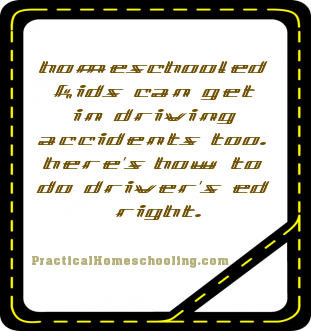 Teenagers tend to get into lots of accidents. Some are due to drunken driving and speeding, some are just due to beginners' mistakes. I don't know of any homeschooled students who have driven drunk or who speed just to show off (homeschoolers are somewhat immune to the peer pressure which leads to such dangerous behavior), but I do know four or five who have gotten into accidents because of beginners' mistakes.
Teenagers tend to get into lots of accidents. Some are due to drunken driving and speeding, some are just due to beginners' mistakes. I don't know of any homeschooled students who have driven drunk or who speed just to show off (homeschoolers are somewhat immune to the peer pressure which leads to such dangerous behavior), but I do know four or five who have gotten into accidents because of beginners' mistakes.
In the very first such accident that I heard about from a mother, a homeschooled boy was driving with his sister and instead of looking at the road was tuning in the car radio and gradually drifting across the center strip of the two lane highway while he did so. Suddenly a truck appeared coming toward them in the same lane. "Look out," yelled his sister. D. looked up, saw a truck coming toward him, turned the steering wheel hard right and skidded off the road into a tree. Fortunately nobody was seriously hurt, though it did take many months for D. and his sister to recover. If D. had just shifted the steering wheel more gradually he would have had plenty of time to get back into his lane without losing control.
Driver education is not required by any home education laws that I know about, but it still may be a good idea, not only to help keep your kids safe and sound, but also to reduce the high insurance rates that result when you have you have a teenage driver in the family. In general, you get 10 percent off the premium of your insurance policy through age 21 if you have a driver's education class. (By the way, many insurance companies also give an additional 15 percent off the premium for students who have grade-point-averages of about 3.0 or better.)
In order to qualify for the drivers' education discount, most insurance companies expect you to show that you have completed both: (1) a 30-hour textbook course, and (2) a six-hour on-the-road component. Usually you have to turn in certificates or cards signed by the instructors to prove that you have completed both components.
Some school districts make their public school driver ed courses available to homeschoolers, but they are not required by law to do so (at least not here in Pennsylvania). One alternative to the textbook component is taking the course through distance learning from Keystone National High School. Call (800) 255-4937 or visit their Internet site at keystonehighschool.com for more info on this course. Cost is $115 plus $10 shipping, which includes textbooks, video, study guide, and subscription to a magazine for student drivers.
You could arrange the on-the-road component with teachers qualified to offer driver education in the schools. Our insurance agent's secretary gave us the names of several driver education teachers in the area who had signed certificate cards for student drivers. One who lived down the road from us agreed to teach our son Jesse the on-the-road component for $90.
Another option is for students to sign up for a course offered by AAA. This covers both the driving and the classroom requirement and costs about $275. A Sears near you may offer driver's ed - and you can find private driving instruction in the Yellow Pages in many areas.
Regardless of how you get official recognition of your driver ed program, a real help when parents are actually getting in the car with their teen to drive, is the $12 book Safe Young Drivers: A Guide for Parents and Teens by Phil Berardelli (ISBN: 1-889324-03-5). This is available from the PA Homeschoolers web site (pahomeschoolers.com).
This book addresses how to actually help your child once you two are out there in that vehicle. Many other programs give valuable background info that the student needs to learn in preparation for getting a learner's permit - this book puts your child in the driver's seat, and gives you the tools to shape safe lessons in the real life act of driving.
It's very complete, guiding you and your teen from the first discussions of where the brake pedal is, to practicing in parking lots, to heading out eventually on the highway and slowly and gradually gaining mastery. Every step is clearly laid out, with sections for the parent to read and sections for the teen.
The author identifies five main themes in safe driving:
- clear the way
- learn the limits
- share the road
- think ahead
- feel the road
It then reinforces these themes in each of the ten lessons, helping students see how these basic ideas are the crux of safe driving.
But perhaps most important is Phil Berardelli's firm insistence that parents need to be in charge of the whole driving decision. He has an excellent chapter helping parents decide if their particular teen is really indeed ready to learn to drive, giving concrete examples of teaching his two daughters to drive. One daughter was ready at 16, the other really needed to wait longer so that she could be more mature and trustworthy. He urges parents not to neglect this responsibility!